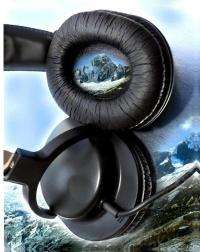Activating the 'mind's eye': Scientists teach blind to read, recognize objects with sounds (w/ Video)

Common wisdom has it that if the visual cortex in the brain is deprived of visual information in early infanthood, it may never develop properly its functional specialization, making sight restoration later in life almost impossible.
Scientists at the Hebrew University of Jerusalem and in France have now shown that blind people – using specialized photographic and sound equipment – can actually "see" and describe objects and even identify letters and words.
The new study by a team of researchers, led by Prof. Amir Amedi of the Edmond and Lily Safra Center for Brain Sciences and the Institute for Medical Research Israel-Canada at the Hebrew University and Ph.D. candidate Ella Striem-Amit, has demonstrated how this achievement is possible through the use of a unique training paradigm, using sensory substitution devices (SSDs).
SSDs are non-invasive sensory aids that provide visual information to the blind via their existing senses. For example, using a visual-to-auditory SSD in a clinical or everyday setting, users wear a miniature camera connected to a small computer (or smart phone) and stereo headphones.
The images are converted into "soundscapes," using a predictable algorithm, allowing the user to listen to and then interpret the visual information coming from the camera. The blind participants using this device reach a level of visual acuity technically surpassing the world-agreed criterion of the World Health Organization (WHO) for blindness, as published in a previous study by the same group.
The resulting sight, though not conventional in that it does not involve activation of the ophthalmological system of the body, is no less visual in the sense that it actually activates the visual identification network in the brain.
The study shows that following a dedicated (but relatively brief) 70 hours of unique training paradigm developed in the Amedi lab, the blind people could easily use SSDs to characterize images into object categories, such as images of faces, houses, body shapes, everyday objects and textures. They could also identify even more complex everyday objects—locating people's positions, identifying facial expressions, and even reading letters and words.
These unprecedented behavioral results are reported in the current issue of the prestigious neuroscience journal, Neuron.
The Hebrew University study went on further to actually test what happens in the brain when the blind learn to see with sounds. Specifically, the group tested the ability of this high-acuity vision to activate the supposedly dormant visual cortex of the blind, even though it was taught to process the visual images through sounds only in adulthood.
Prof. Amedi, and Ella Striem-Amit used functional magnetic resonance imaging (fMRI) to measure the neural activity of people blind from birth as they "saw"—using the SSD—high-resolution images of letters, faces, houses, everyday objects and body-shapes. Surprisingly, not only was their visual cortex activated by the sounds, their brain showed selectivity for visual categories which characterize the normally developing, sighted brain.
A specific part of the brain, known as the Visual Word Form Area, or VWFA—that was first discovered in sighted people by Profs. Laurent Cohen and Stanislas Dehaene of Pitie-Salpétriere Hospital-INSERM-CEA, of France, co-authors of the current article—is normally very selective.
In sighted people, it has a role in reading, and is activated by seeing and reading letters more than by any other visual object category. Astonishingly, the same was found in this area in people deprived of sight. Their VWFA, after only tens of hours of training in SSD use, showed more activation for letters than for any of the other visual categories tested.
In fact, the VWFA was so plastic to change, that it showed increased activation for SSD letters after less than two hours of training by one of the study participants.
"The adult brain is more flexible that we thought," says Prof. Amedi. In fact, this and other recent research from various groups have demonstrated that multiple brain areas are not specific to their input sense (vision, audition or touch), but rather to the task, or computation they perform, which may be computed with various modalities. (This information was summarized in a recent review by the Amedi research group published in the journal Current Directions in Neurology.)
All of this suggests that in the blind, brain areas might potentially be "awakened" to processing visual properties and tasks even after years or maybe even lifelong blindness, if the proper technologies and training approaches are used, says Amedi.
The findings also give hope that reintroduced input into the visual centers of the blind brain could potentially restore vision, and that SSDs might be useful for visual rehabilitation.
"SSDs might help blind or visually-impaired individuals learn to process complex images, as done in this study, or they might be used as sensory interpreters that provide high-resolution, supportive, synchronous input to a visual signal arriving from an external device such as bionic eyes" says Prof. Amedi.
More information: Teaching the Blind to Read and Recognize Objects with Sounds, Neuron, DOI: 10.1016/j.neuron.2012.08.026

















